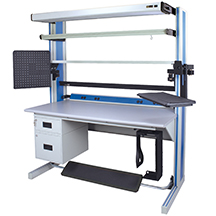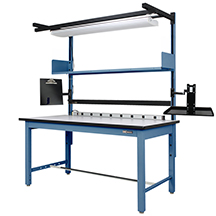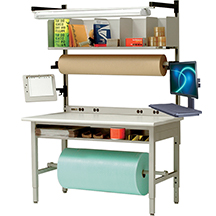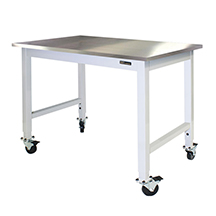Assembly Workstations Cut Operating Costs
Big Cuts in Worker’s Comp Costs and Lost Workdays
“Harmon, at the executive level, is fully committed to the ergonomics program. Funding is just part of the yearly budget.&rdquo – Chad Stotler, Harmon Industiries
Direct workers compensation costs, and lost injury and illness days were not acceptable at Harmon Industries (Grain Valley, MO and Riverside, CA) three years ago. Today, after implementing an ergonomics program, Harmon can boast about its health and safety record.
Chad Stotler, Harmon’s plant environmental health and safety manager, started by educating management about the high cost of work-related injuries and proposed an ergonomics program. With strong managerial support, the plant environmental health and safety team reduced direct workers compensation costs at the Grain Valley facility from $183,000 in 1997 to $17,000 in 1999. Lost workdays were reduced from 300 in 1997 to 0 in 1998 and 9 in 1999 at the Riverside facility, with similar reductions at the Grain Valley facility.
Harmon manufactures electronic signal control equipment for freight and transit systems.
Two major ergonomic concerns were identified: back injuries from heavy material handling and lifting in assembling the chassis for the signal controls; and musculoskeletal complaints in the shoulders and neck from employees performing circuit board assembly. To address these concerns, Stotler enlisted the cooperation of management to provide leadership in ergonomics and support for a comprehensive project, including hazard assessment, employee training and communication, an employee exercise program, and new workstations and carts from IAC, a Division of Treston.
The objective was to decrease ergonomic risk factors, even though reduction of all forceful tasks was not possible. To accomplish this objective, Harmon selected Dimension 4 (D4) workstations with integrated hydraulic height-adjustment capability and pneumatically controlled ball transfer systems.
Because of the chassis size, employees usually perform assembly while standing. Height-adjustable work surfaces allow an employee to position the product at the right working height to match his or her particular needs, and the working height can be adjusted to accommodate different sizes of chassis or different assembly tasks. The height-adjustable feature was key to achieving Stotler’s objective of reducing the force requirements when moving chassis from carts to the work surface.
The ball transfer system accommodates the size, shape and friction characteristics of the chassis and eliminated excessive force requirements when turning the chassis during assembly. To rotate the chassis, the employee activates the pneumatic all transfer system. Metal balls recessed in the work surface rise up providing a free-flowing surface for repositioning the chassis. Once the chassis is correctly positioned, the employee disengages the ball transfer system, which allows the balls to recess into the work surface, leaving the chassis resting securely so the employee can continue assembly.
The cart IAC developed for Harmon has tubular rollers inserted in part of its top surface. To transfer a chassis between a cart and a D4 work surface, the cart is positioned adjacent to the D4. Then, using the hydraulic height-adjustment capability of the workstation, the D4 work surface is positioned at the same height as the cart surface. The employee activates the D4’s ball transfer system, and the chassis can then be easily rolled off the cart surface onto the raised, air-activated roller balls and positioned as needed on the D4 work surface. Almost all heavy material handling and lifting is eliminated for this transfer task.
The shoulder and neck problems reported when working on circuit boards required a different approach. Instead of lifting and pushing, employees were working with extreme neck flexion, and raised and abducted shoulders as they worked on circuit boards positioned flat on a fixed-height work surface.
A tilting table inserted in the main surface of the workstation remedied the problem. A ratchet lets assemblers adjusts the work surface to a comfortable angle. The hydraulically adjustable D4 workstations allow the circuit board assemblers to optimize the height of the work surface to find the most comfortable posture. The inserted approach minimizes the total working height between the underside of the work surface and the top of the circuit boards, which is appreciated by seated employees with torsos too short to sit comfortably and work on products that are positioned too high after sufficient leg clearance in provided. The hydraulic feature also allows for easy height adjustment because of the interchange of employees and workstations.
The workstations and carts have been in place at Harmon for almost three years, which is now experiencing significant savings from the reduction of workers compensation and lost workdays.
 Buy Online Now!
Buy Online Now!
 Buy Online Now!
Buy Online Now!











